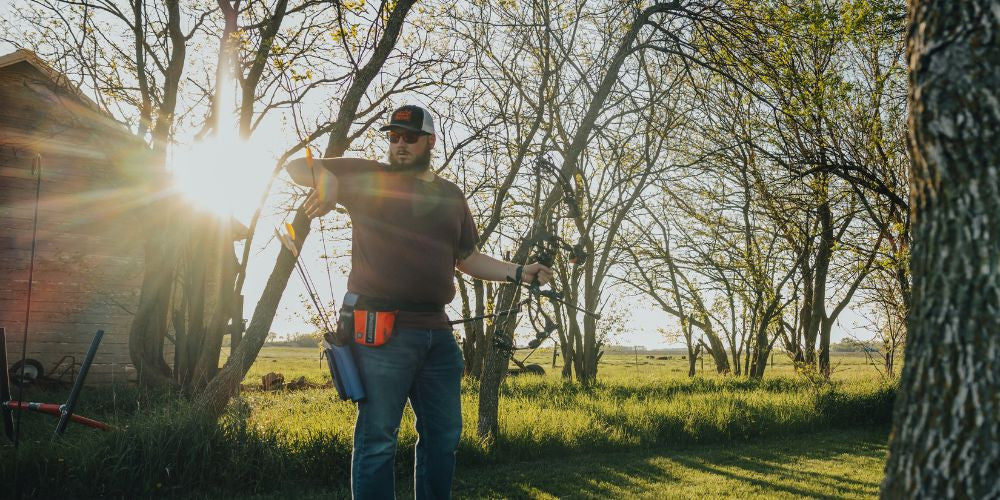Everyone you know may be posting about pumpkin spice lattes and colorful leaves, but for archers, October also signals the start of the indoor archery season. Whether you’re new to archery this year, or an indoor gold medalist, here are three tips everyone can use to improve their indoor game:
1. Get your gear on point
If you’re switching from an outdoor setup to an indoor setup, a small investment of time can have a major impact on your bow’s performance (and your sanity).
First, use a note-taking app to make a record of your bow setup as you’ve used it for outdoor season, including bow weight, arrow specs, arrow rest type and where it’s positioned, and your stabilizer/weight configuration. Be sure to take photos as well, so you have a clear record of exactly how your outdoor setup works before you change anything for indoors, so that you can change it back next spring.
If you’re a compound archer, you might find that one type of arrow rest shoots better indoors than out, and you’re likely to need adjustments even if you’re sticking with the same rest but changing arrows for indoor season. If you’re able, keep your outdoor rest intact and simply remove it from the bow, and pop a new arrow rest on for indoor season. For recurve archers, the same goes for the plunger; try to keep separate ones for indoor and outdoor season, because it can be difficult to duplicate plunger settings once they’ve been changed.
There are some archers who won’t change arrows from outdoor season to indoor season, and that’s okay, too. If you’re not making any changes, just be sure that you still keep a good record of your archery equipment so that if something breaks or is lost, you can make an exact replacement quickly.

2. Learn the Game
Indoor archery tournaments can be hosted by target, field and 3-D archery organizations. Depending on where you live, you might be able to choose from a variety of local, state and regional competitions, or your options may be limited by the type of archery that’s popular in your area.
Whatever archery game you decide to play, take the time to learn the rules, from how to shoot your target to scoring. The rules at some National Field Archery Association tournaments, for example, could differ from World Archery’s format. Here are some good questions to research:
- What’s the objective of the game?
- How many arrows are shot in a round?
- What does the target look like?
- How many arrows are shot per end?
- How are the targets scored?
- Is there head-to-head competition (matchplay)?
- What are the rules of the game?
- What kinds of archery equipment and accessories can I use?
- Is there a dress code, and if so, what is it?
- Which tournaments can I shoot?
By asking these simple questions, you can set yourself up for success, whether it’s your first indoor archery season or just the first time you’re trying a new round.
3. Set a Goal, and Get Started!
Now that your equipment is ready and you know what kinds of indoor archery rounds you want to shoot, it’s time to set some goals and work toward reaching them.
If this is your first indoor season, or if you’re shooting a new indoor game for the first time, your goal should really just be to learn: learn the round, the rules, how to compete, and develop confidence in an unfamiliar environment. If you’ve shot indoor archery before, your goals might be a bit more involved: perfecting your shot process indoors, setting a new personal best at a tournament, or earning a spot on the podium.
Remember that even though indoor tournaments tend to have fewer arrows required per day than outdoor tournaments, your shots and scores will still only be as good as your commitment to practicing. The target is where you’ll see your efforts pay off (or not). Even though the days are short and temps become cold, practice is still a necessity, even if indoors at very short distances. If you’re planning to shoot tournaments, be sure to learn the format and practice keeping score: this will help develop confidence.
Finally, as you progress through your indoor archery season, be sure to keep good notes. Things you should write down: how your tournaments went, what you liked most about the season, which things affected you positively or negatively during practice, and changes you’d like to try making to your bow. By keeping notes, you’ll be able to see your accomplishments, track your progress and be even more efficient in planning for future indoor archery seasons!
 cust@legendarchery.com
cust@legendarchery.com 302 503 5767
302 503 5767 Whitestown, In 47075
Whitestown, In 47075





